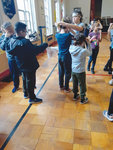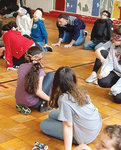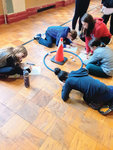By JEN COWART Special to the Herald This year, the Accelerated Teaching of Math and Science, or ATOMS, club at Cranston High School West has gained enough student interest that expansion into an additional elementary school has become necessary this
This item is available in full to subscribers.
We have recently launched a new and improved website. To continue reading, you will need to either log into your subscriber account, or purchase a new subscription.
If you are a current print subscriber, you can set up a free website account by clicking here.
Otherwise, click here to view your options for subscribing.
Please log in to continue |
|



Special to the Herald
This year, the Accelerated Teaching of Math and Science, or ATOMS, club at Cranston High School West has gained enough student interest that expansion into an additional elementary school has become necessary this year.
The extracurricular club began when Susan Weber, a now fifth-grade teacher at Rhodes Elementary School, and Jo-Ann Mangiarelli, a high school science teacher at West, were seated together at a summer professional development conference. Their shared desire to connect older and younger students with each other led to a partnership which had already grown in popularity.
ATOMS has added more students at the high school level and additional teachers at the elementary school, has now expanded to include an additional Cranston elementary school as well.
The high school students meet periodically after school to prepare for the lessons and activities that they will be teaching at the elementary school level. Weber and her fifth-grade partner, Jim Gemma, make sure that the lessons and materials are prepped at the school when the ATOMS bus arrives.
It is a mutual enthusiasm for science on behalf of both the students and the staff that keeps the program going, with the high school students looking forward to the visits as much as the children at the elementary level.
On a recent Monday morning at Rhodes, the students split up into groups in the gymnasium for the first activity, “Cycling of Matter.” The game had the students rotating through stations around the room, dependent on a roll of the dice telling them which station they would be heading to next. While some student groups moved to a plant or animal station, others moved to a station about decomposers, water or oxygen.
“This is really applicable to what we are doing in class right now because we were growing seeds in plastic bags, with the water and the seeds inside the sealed bag,” Weber said. “We talked about how the seeds changed into plants if no other matter got into the bags.”
Once the students had rolled the dice and rotated through their stations, they sat in groups, and drew their particular cycle of matter, with each group’s picture being different depending on what their roll of the dice led to.
During the second part of the 1½-hour visit, the students played a whole-group game called Meerkat in which the students play the parts of the meerkats, grouped into their underground communities, called mobs. A student from each group is chosen to be the lookout meerkat, or scout. With the members of the six “mobs” blindfolded, it is the scouts’ responsibility to alert the mob when a predator is nearby, using a mutually agreed-upon mob code sound to give the alert.
The staff members from both schools – adequately prepared with their sneakers on – started out as the predators, running and jumping stealthily through the various mobs, trying to prey on the blindfolded meerkats, which is indicated by tagging the students. Once tagged by a predator, the students must sit until the next round. As the game progressed, the high school students moved out of the role of meerkats and into the role of predators, increasing the danger for the mobs.
“All of the students at both levels look forward to this game,” Weber said. “This year’s students hadn’t played the game before, but they had heard a lot about it so they couldn’t wait to play it.”
The groups will meet again before the year ends, with different games and activities planned for each visit at each school.
Comments
No comments on this item Please log in to comment by clicking here